 |
     |
 |
 |
 |
|
Science at CBC High School works toward the development of the whole man through investigation of the natural world via the scientific method. This is accomplished by developing science from the foundation of physics, to the applications of chemistry and biology and the enabling of further study into more specific fields of scientific inquiry. To engage and challenge our students, courses necessarily incorporate significant hands-on time in the laboratory.
CBC science will acquaint our students with the major tools and concepts of science and the major problems confronting not only the scientific community but the world community at large, and in so doing will inspire our students to become active problem-solvers.
Course Sequence Diagram |
|
|
| |
|
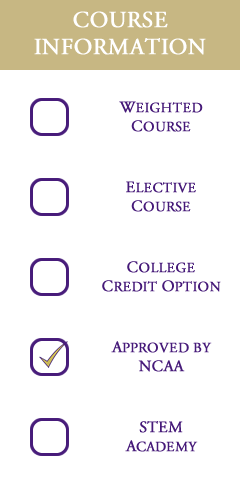 |
| College Prep |
2 Semesters |
1.0 Credit |
| Prerequisites: Open to Freshmen |
|
| Course Description: This course introduces the basic concepts of physics as the science of matter and energy and the interactions of the two. As such, physics forms the foundation of all sciences. This laboratory-intensive course will use the modeling approach to science education and will focus on the study of motion, forces, and energy. |
|
 |
|
|
| |
|
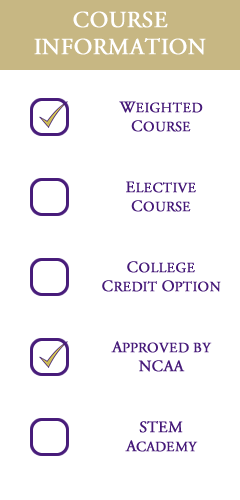 |
| Honors / A.P. |
2 Semesters |
1.0 Credit |
| Prerequisites: Open to Freshmen; Department approval |
|
| Course Description: This course introduces the basic concepts of physics as the science of matter and energy and the interactions of the two. As such, physics forms the foundation of all sciences. This laboratory-intensive course will use the modeling approach to science education and will focus on the study of motion, forces, and energy. The course includes mathematical computations of increasing difficulty and complexity relative to the Physics course. |
|
 |
|
|
| |
|
 |
| College Prep |
2 Semesters |
1.0 Credit |
| Prerequisites: Open to Sophomores; Department approval; Algebra 1 |
|
| Course Description: This course introduces the basic concepts of chemistry, which includes the description and properties of matter, interactions of different types of matter (chemical reactions), and the role of energy in these interactions. This laboratory-intensive course will use the modeling approach to science education and will focus on the particle model of matter, leading into the mole concept, qualitative and quantitative behavior of matter, chemical reactions, and chemical analysis. The course emphasizes problem-solving and descriptive chemistry. |
|
 |
|
|
| |
|
 |
| Honors / A.P. |
2 Semesters |
1.0 Credit |
| Prerequisites: Open to Sophomores; Department approval; Algebra 1 |
|
| Course Description: This course introduces the basic concepts of chemistry, which includes the description and properties of matter, interactions of different types of matter (chemical reactions), and the role of energy in these interactions. This laboratory-intensive course will use the modeling approach to science education and will focus on the particle model of matter, leading into the mole concept, qualitative and quantitative behavior of matter, chemical reactions, and chemical analysis. The course emphasizes problem-solving and descriptive chemistry. The course includes an increased pace and mathematical computations of increasing difficulty and complexity relative to the Chemistry course. |
|
 |
|
|
| |
|
 |
| College Prep |
2 Semesters |
1.0 Credit |
| Prerequisites: Open to Juniors |
|
| Course Description: This course will introduce students to the molecules of life, cytology, DNA technology, genetics, evolution, classification, and the kingdoms of living things. This laboratory-intensive course will use the modeling approach to science education. |
|
 |
|
|
| |
|
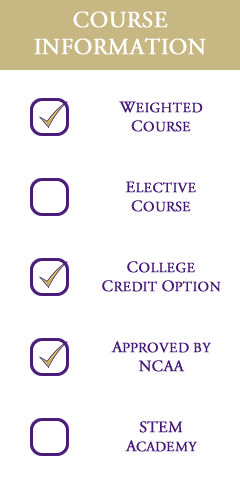 |
| Honors / A.P. |
2 Semesters |
1.0 Credit |
| Prerequisites: Open to Juniors and Seniors; Teacher recommendation; Department approval; A.P. Chemistry grade above 80% or Honors Chemistry grade above 85% or Chemistry grade above 90% |
|
Course Description: This course involves study in the areas of the chemistry of life, cell structure and function, cellular energetics, cell communication and the cell cycle, heredity, gene expression and regulation, natural selection, and ecology. The focus of the class will be lab skills and project development on the aforementioned mentioned topics.
Students are eligible for college credit through the University of Missouri-St. Louis. |
|
 |
|
|
| |
|
 |
| Honors / A.P. |
2 Semesters |
1.0 Credit |
| Prerequisites: Open to Juniors and Seniors; Teacher recommendation; Department approval; A.P. Chemistry grade above 85% or Honors Chemistry grade above 90% |
|
Course Description: This course involves independent study, class discussion, and laboratory work in the areas of the chemistry of life, cell structure and function, cellular energetics, cell communication and the cell cycle, heredity, gene expression and regulation, natural selection, and ecology.
The focus of this course will be on preparing students for the A.P. Exam. Students are eligible for college credit through the University of Missouri-St. Louis. |
|
 |
|
|
| |
|
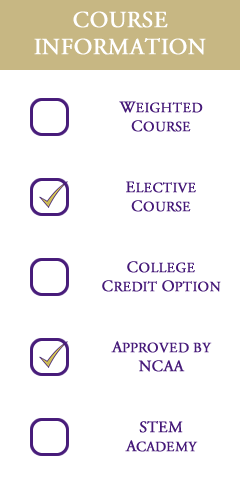 |
| College Prep |
1 Semester |
.5 Credit |
| Prerequisites: Open to Juniors and Seniors; Department approval; Two years of previous Science courses; Chemistry grade above 80% |
|
| Course Description: An elective science course that is a continuation of the required Sophomore Chemistry course using the familiar lab-intensive, modeling-based approach. After a brief review of previously learned chemistry concepts, this course continues in-depth with models of the atom, periodic table trends, bonding, intermolecular attractions, biological molecules, and acid-base equilibrium. This course is intended for students who seek a deeper understanding of chemistry without the broad scope and intensive pace of A.P. Chemistry. |
|
 |
|
|
| |
|
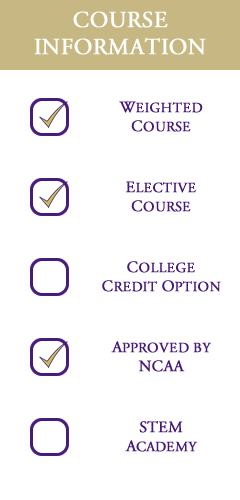 |
| Honors / A.P. |
2 Semesters |
1.0 Credit |
| Prerequisites: Open to Juniors and Seniors; Teacher recommendation; Department approval |
|
Course Description: This is an in-depth course intended to enhance higher-order critical thinking skills and problem-solving abilities. Topics covered include electrochemistry, qualitative analysis, thermochemistry, organic chemistry, reaction rates, and colligative properties. Topics will be developed through intensive laboratory experiences.
The focus of this course will be on preparing students for the A.P. Exam. |
|
 |
|
|
| |
|
 |
| Honors |
2 Semesters |
1.0 Credit |
| Prerequisites: Open to Juniors and Seniors; Teacher recommendation; Department approval; Two years of previous Honors or Level 1 Science courses |
|
| Course Description: This course will be an in-depth analysis of physics concepts using a project-based methodology. The physics concepts will be introduced as a way to solve authentic problems. Students will be required to organize and prioritize the tasks needed to accomplish the goal, including self-study on the physics involved (with support from the teacher). All projects will culminate in some type of public exhibition. An example project is the design of stop light timings on a stretch of road, which would require adequately defining ideas such as kinematics and dynamics. There will be several projects assigned as a class and several in which the students can solve a problem of their own choosing. Topics could include kinematics, dynamics, rotational motion, energy, momentum, waves, electricity, magnetism, optics, modern physics, or thermodynamics. This course will place a heavy emphasis on communication, collaboration, creativity, and critical thinking throughout the problem-solving process. |
|
 |
|
|
| |
|
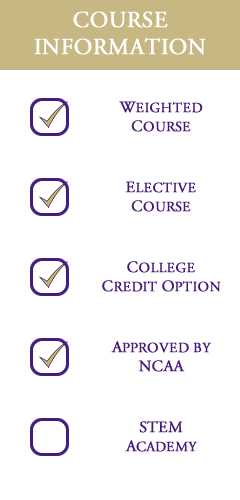 |
| Honors / A.P. |
2 Semesters |
1.0 Credit |
| Prerequisites: Open to Juniors and Seniors; Teacher recommendation; Department approval; Geometry grade 90% or above |
|
Course Description: This course includes an in-depth study of the basic concepts of physics, which is the study of matter and its interactions. Specific topics that will be covered include: Newtonian mechanics (including rotational motion), work, energy and power; mechanical waves and sound, and introductory, simple circuits. Topics will be developed through intensive laboratory experiences.
The focus of this course will be on preparing students for the A.P. Physics 1 Exam. |
|
 |
|
|
| |
|
 |
| Honors / A.P. |
2 Semesters |
1.0 Credit |
| Prerequisites: Open to Seniors; Teacher recommendation; Department approval; A.P. Physics 1; Concurrent enrollment in Calculus |
|
Course Description: This course includes an in-depth study of the basic concepts of physics, which is the study of matter and its interactions. This course is a follow-on course to Advanced Placement Physics I. Specific topics which will be covered include principles of fluids, thermodynamics, electricity, magnetism, optics, and topics in modern physics. Topics will be developed through intensive laboratory experiences.
The focus of this course will be on preparing students for the A.P. Phyiscs 2 Exam. |
|
 |
|
|
| |
| A.P. ENVIRONMENTAL SCIENCE |
|
 |
| Honors / A.P. |
2 Semesters |
1.0 Credit |
| Prerequisites: Open to Seniors; Teacher recommendation; Department approval; Three years of previous Science courses; Biology (Level 1) grade above 90% or A.P. Biology grade above 80% |
|
Course Description: This course involves independent study, class discussions, text analysis, and laboratory work in the areas of ecosystems, biodiversity, populations, earth systems and resources, land and water use, energy resources and consumption, pollution, and global change.
The focus of this course will be on preparing students for the A.P. Environmental Science Exam. Students are eligible for college credit through the University of Missouri-St. Louis. |
|
 |
|
|
| |
|
 |
| College Prep |
1 Semester |
.5 Credit |
| Prerequisites: Open to Seniors; Department approval; Three years of previous Science courses |
|
| Course Description: This course will study the relationships of the living and non-living world and how humans interact with their environment. Environmental Science will incorporate other branches of science including biology, meteorology, chemistry, oceanography, geology, and physics. Topics will include ecosystems, the earth, populations, biodiversity, pollution, climate change, and non- and renewable resources. Topics will be explored through laboratory exercises. |
|
 |
|
|
| |
|
 |
| College Prep |
1 Semester |
.5 Credit |
| Prerequisites: Open to Juniors and Seniors; Department approval; Two years of previous Science courses |
|
| Course Description: This course will introduce and study the basic concepts of fire and combustible materials. It will explore the theories and fundamentals of how and why fires start, spread, and are controlled. Focus will also be given to hazardous materials, their reactivity, and identification of health hazards encountered through exposure. Topics will be explored through laboratory exercises and project-based learning opportunities. |
|
 |
|
|
| |
|
 |
| College Prep |
1 Semester |
.5 Credit |
| Prerequisites: Open to Seniors; Teacher recommendation; Department approval; Three years of previous Science courses |
|
| Course Description: This course will cover the basic science involved in forensics. Problem-solving using deductive reasoning will be emphasized through the study of crime scenes, fingerprinting, firearms identification, forgery, and famous historical crimes. Topics will be illustrated through hands-on laboratory activities. |
|
 |
|
|
| |
|
 |
| College Prep |
1 Semester |
0.5 Credit |
| Prerequisites: Open to Seniors; Teacher Recommendation; Department approval; Three years of previous Science courses |
|
| Course Description: This course provides a foundation for further study in the Health Sciences field. This includes the study of the structure and function of human body organization. Laboratory work, including several dissections, is an essential part of this course. |
|
 |
|
|
| |
| HONORS HUMAN ANATOMY/PHYSIOLOGY |
|
 |
| Honors / A.P. |
2 Semesters |
1.0 Credit |
| Prerequisites:Open to Seniors; Department approval; Biology (Level 1) grade above 90% or A.P. Biology grade above 80% |
|
Course Description: This course will cover the structures and functions of the human body. Emphasis will be placed on the following systems: integumentary, skeletal, muscular, cardiovascular, digestive, respiratory, and reproductive. Special emphasis will be placed on how the human body adapts itself to its environment and how changes affect physiological activities. Laboratory work is an essential part of this course.
Students are eligible for college credit through the University of Missouri-St. Louis. |
|
 |
|
|
| |
|
 |
| College Prep |
1 Semester |
.5 Credit |
| Prerequisites: Open to Seniors; Teacher recommendation; Department approval; Three years of previous Science courses |
|
| Course Description: This course covers aspects of two distinct scientific disciplines: oceanography and marine biology. Oceanography is the study of the physical properties that make up the ocean, plate tectonics, the formation of the ocean floor, tides and lunar phases, interpretation of the tide table, tsunamis, and the processes that generate currents and waves. Marine biology is the relationship between biological organisms and their environment.
|
|
 |
|
|
| |
|
 |
| College Prep |
1 Semester |
.5 Credit |
| Prerequisites: Open to Seniors; Department approval; Three years of previous Science courses |
|
| Course Description: This course will introduce the basic concepts of nuclear science: ionizing and non-ionizing radiation, radiation safety and protection, and health physics applications in the medical field. Students will investigate nuclear fusion occurring on the sun, fission in nuclear reactors, radioactive decay and carbon dating, and types of radioactive particles. Topics will be explored through laboratory exercises. |
|
 |
|
|
| |
|
 |
| College Prep |
1 Semester |
.5 Credit |
| Prerequisites: Open to Seniors; Teacher recommendation; Department approval; Three years of previous Science courses |
|
| Course Description: This is a project-based course applying concepts previously learned in the required science sequence to topics in space science. The topics covered will be in-part determined by the interests of the students from a set of projects including telescopes, rocketry, the night sky, planetary motion, life of stars, structure of galaxies, the Big Bang, and large scale structure of the universe. Exploration of space will be both via computer simulation and first-hand observation. Some projects may require activities outside the classroom or field trips.
|
|
 |
|
|
| |
|
 |
| College Prep |
1 Semester |
.5 Credit |
| Prerequisites:Open to Seniors; Department approval; Three years of previous Science courses |
|
Course Description: Topics include the origin of animal life, classification of major phyla of animals and the major classes of vertebrates, anatomy and physiological function of representative organisms, animal reproduction and development, and basic concepts of animal behavior and ecology. Students should be aware that this course includes a variety of dissections.
|
|
 |
|
|
























